

|
|
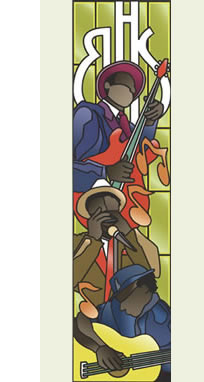 |
 For the twelfth year, Blue Heaven Studios will host the world-renowned Blues Masters at the Crossroads, a two-night concert housed in a converted church sanctuary. You've never been to a concert like this! Purchase Tickets to the 12th Annual Blues Masters at the Crossroads
|
| Friday, October 16th |
 Marcia
Ball Marcia
BallSinger/pianist Marcia Ball knows how to raise roofs and tear down walls with her infectious, intelligent and deeply emotional brand of southern boogie, rollicking roadhouse blues and heartfelt ballads. Her exquisite piano playing and passionate, playful vocals fuse New Orleans and Gulf Coast R&B with Austin's deep songwriting tradition into a sound No Depression describes as "a little rock, a lot of roll, a pinch of rhythm and a handful of blues." Born in Orange, Texas, in 1949 to a family whose female members all played piano, Ball grew up in the small town of Vinton, Louisiana, right across the border from Texas. She began taking piano lessons at age five, playing old Tin Pan Alley tunes from her grandmother's collection. But it wasn't until she was 13 that Ball discovered the blues as, one day in 1962, she sat amazed while Irma Thomas delivered the most soulful and spirited performance the young teenager had ever seen. According to Ball, "She just blew me away; she caught me totally unaware. Once I started my own band, the first stuff I was doing was Irma's." In 1966, Ball attended Louisiana State University, where she played some of her very first gigs with a blues-based rock band called Gum. In 1970, Ball set out for San Francisco. Her car broke down in Austin, Texas, and while waiting for repairs, she fell in love with the city and decided to stay. It wasn't long before she was performing in the city's clubs with a progressive country band called Freda and the Firedogs. It was around this time that she delved deeply into the music of the great New Orleans players, especially Professor Longhair. "Once I found out about Professor Longhair," recalls Ball, "I knew I had found my direction." When the band broke up in 1974, Ball launched her solo career, signing to Capitol Records and debuting with the country album Circuit Queen in 1978. She released six critically acclaimed albums on the Rounder label during the 1980s and 1990s. In 1990, Ball – collaborating with Angela Strehli and Lou Ann Barton – recorded the hugely successful Dreams Come True on the Antone's label. At the end of 1997, Ball finished work on a similar "three divas of the blues" project for Rounder, this time in the distinguished company of Tracy Nelson and her longtime inspiration, Irma Thomas. The album, Sing It!, was released in January 1998 and was nominated for both a Grammy and a Blues Music Award as "Best Contemporary Blues Album." She also received the 1998 Blues Music Award for "Contemporary Female Vocalist Of The Year" and for "Best Blues Instrumentalist-Keyboards." Ball again won the "Pinetop Perkins Piano Player Award" at the Blues Music Awards in Memphis this May. Since 2001, Ball has been with Alligator Records, releasing four titles to date. With Alligator's superior distribution and tour support, Ball's popularity has soared as she's been the feature of recent stories in such national publications as USA Today, DownBeat, Billboard, U.S. News & World Report and Keyboard. |
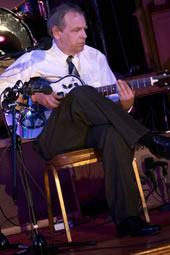 Leroy
Jodie Pierson Leroy
Jodie PiersonBack by popular demand is Leroy Jodie Pierson, who first appeared at the Blues Masters in 2004 and in doing so made "believers" out a church full of previously uninformed. Pierson was likely unknown to all of the 2004 crowd but the ones from St. Louis. But his guitar brilliance in interpretations of classic Mississippi Fred McDowell, Son House, Robert Johnson and others easily made Pierson one of the 2004 fest's fan favorites. Also that weekend, APO Records, the home label of Blue Heaven Studios, made a direct-to-disc, vinyl-only recording of Pierson. That limited-edition pressing drew tremendous praise from knowing reviewers. David Glackin of Positive Feedback Online called it "one of my top three blues albums of all time…one of the top bluesmen of our era…sounds like he's been transported directly from ages past." But the highest praise of all came years ago from blues master Henry Townsend, who played Blues Masters two in 1999 and to whom Blues Masters nine was dedicated after his death in 2006. Townsend said of Pierson: "Leroy is really one of the very best bluesmen I've ever played with, and I've played with most of the greats, guys like Walter Davis, Robert Nighthawk, Sonny Boy Williamson, Robert Johnson and Roosevelt Sykes. Leroy is up there with those greats." Pierson, born in St. Louis in 1947, was introduced to music early in life by his father who played guitar and fiddle in western swing bands. Pierson took up guitar himself at age 13. He was first exposed to blues music on disc jockey Gabriel's show on St. Louis station KATZ in the mid 1950s. At the time Pierson thought the sounds he heard were pop music, but in retrospect he thinks they served as an early grounding in good taste. The early to mid-'60s saw reissues of pre-war blues marketed on albums and Pierson bought them all as they were released. While at college in Beloit, Wisconsin, he gained skills in producing blues shows and festivals. He also spent time in the deep South interviewing and performing informally with many of the blues legends who helped to shape the identity that Pierson has attained. Some performers he interviewed and/or produced shows for include Mississippi Fred McDowell, Son House, Arthur Crudup, Johnny Shines, Robert Lockwood Jr. and of course, Henry Townsend. Pierson is also a very respected blues historian and radio DJ, and interestingly is considered a foremost authority on reggae music. He co-authored Bob Marley And The Wailers: The Definitive Discography, an extraordinarily detailed breakdown of all that the band ever recorded. Pierson has also produced several blues and reggae recordings. |
 Honeyboy Edwards
Honeyboy EdwardsThe whole reason the Blues Masters at the Crossroads began in 1998 was to showcase and document artists like Honeyboy Edwards. Now, there are no more artists like Honeyboy Edwards. There were nine headliner performers at the first Blues Masters. Only three of them are still living. Two – Jimmy D. Lane and Eomot RaSun – were the definite Young Turks of Blues Masters one. The other is David "Honeyboy" Edwards, truly the last of a breed. The word "breed" applies because think about this: At 94 years old, Edwards and Blues Masters alum Pinetop Perkins are the very end of the road as it concerns bluesmen with links to the origins of blues recordings. They're among the last with ties to sharecropping, who picked cotton, who hoboed trains – the last to live a life reminiscent of the themes we so strongly associate with classic blues. Edwards was born June 28, 1915 in Shaw, Mississippi. Of his earliest musical inspiration, Edwards says in his autobiography The World Don't Owe Me Nothing, "it was in '29 when Tommy Johnson come down from Crystal Springs, Mississippi. He was just a little guy, tan colored, easy-going; but he drank a whole lot. At nighttime, we'd go there and listen to Tommy Johnson play. Listening to Tommy, that's when I really learned something about how to play guitar." Edwards' life has been intertwined with almost every major blues legend, including Robert Johnson, Charley Patton, Big Joe Williams, Rice "Sonny Boy Williamson" Miller, Howlin' Wolf, Peetie Wheatstraw, Sunnyland Slim, Lightnin' Hopkins, Big Walter, Little Walter, Magic Sam, Muddy Waters and on and on. In 1942, Alan Lomax recorded Edwards in Clarksdale, Mississippi, for the Library of Congress. He recorded 15 sides of Edwards' music. Edwards didn't record again commercially until 1951, when he cut "Who May Your Regular Be" for Arc Records. He also recorded "Build A Cave" as "Mr. Honey" for Artist. Moving to Chicago in the early '50s, Edwards played small clubs and street corners with Floyd Jones, Johnny Temple and Kansas City Red. In '53, he recorded several songs for Chess that remained un-issued until "Drop Down Mama" was included in an anthology release. Edwards began a still-ongoing association with Earwig Records in 1979 when he and his friends Sunnyland Slim, Kansas City Red, Floyd Jones and Big Walter Horton recorded Old Friends for the label. Earwig also released Edwards' Library of Congress performances along with more recent recordings as part of Delta Bluesman in 1992. What a remarkable treat to hear the undisputed elder statesman, the very last link to Robert Johnson, to Charley Patton to Alan Lomax to plantation living. That's living, breathing history sitting up on that stage. And when he's gone, so too is one hell of an important era. |
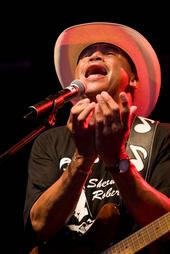 Sherman
Robertson Sherman
Robertson"Sherman Robertson deserves to have his name added to the short list of the finest musicians who play electric blues." – Living Blues "Some of the best Texas soul-blues anyone could hope for. Potent singing and sizzling guitar…Sherman Robertson is one of the most important artists in blues." - Blues Revue Sherman Robertson plays zydeco, hard-swinging Texas electric blues, R&B and swampy Louisiana blues, all with a rock edge. "I use that driving, road-cooking type zydeco groove, and put blues on top of it," says Robertson. "It's basically rhythm and feel." Robertson was born in Breaux Bridge, Louisiana, in 1948 and raised in Houston, Texas. He got the music bug first after seeing country legend Hank Williams on TV. "I didn't know it was country," Robertson remembers. "It sounded blues to me because he had that blues thing in his voice. Just beat and weary but yet great – his voice just captured me." Robertson quickly earned a local reputation as a very good guitarist. While still in school, Robertson was recruited by his teacher, Conrad Johnson, to play in his popular group, Connie's Combo. As a teenager in the late 1960s, he spent six weeks on the road as lead guitarist with blues superstar Bobby "Blue" Bland and also backed Junior Parker. That gave Robertson the incentive to form his own band, Sherman Robertson and the Crosstown Blues Band with whom he recorded two albums on the Lunar II label. During the 1970s, Robertson was content playing weekends while raising a family and holding down a "regular" job until Clifton Chenier, "the King of Zydeco," asked him to do some dates with his band. Those few dates turned into five years, as Robertson toured the U.S. and Europe with Chenier. He then joined Terrance Simien's hot, young zyedeco band and briefly played with Rockin' Dopsie, Johnny Clyde Copeland and several other well-known artists. The word on Robertson's talent began to spread. Paul Simon needed a guitar player to add some sounds to his Graceland album and he chose Robertson. Soon after, legendary British producer Mike Vernon (John Mayall's Bluesbreakers with Eric Clapton, Freddie King, Fleetwood Mac, David Bowie) signed Robertson to Atlantic Records. Robertson's first solo recording, 1993's I'm The Man, was nominated for a W.C. Handy Award. His second Atlantic title, Here And Now, was released in 1996 to more critical acclaim. Convinced he would have more promotional support and artistic freedom from an independent label, Robertson weighed his options. In early 1998, producer Joe Harley (who is the person who came up with the name "Blue Heaven Studios" and has worked here in the old church) assembled a first-class backup band that included Little Feat members Bill Payne and Richie Hayward for a record called Going Back Home on the AudioQuest label. Blues Revue said of the release, "Potent singing and sizzling guitar…Robertson is unstoppable." In 2005, Robertson recorded for the Movin' Music label and again in 2006 for Crosscut Records. |
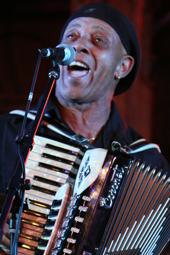 Major
Handy Major
HandyMajor Handy's brand-new record, Zydeco Feeling, is among the strongest front-to-back offerings in the APO Records catalog. And track three – "I'm On The Wonder" – might just be the best slow blues ever recorded in this old church. Accordion-led and with half the lyrics in French, that seems a strange declaration to the unknowing, but Major Handy offers such bare emotion, building and smoldering, the performance on each song seemingly inspiring the next. This is just a damn fine record, and from an artist few aside from Blues Masters regulars and those in southwest Louisiana will have ever heard. Major Handy was actually born "Joseph Majay Handy," May 15, 1947. He thinks, if he understands what his mother's told him, that his parents had a child before him and named that boy "Joseph Majay Handy." That son died near birth, and when the couple had their next child, also a boy, they decided to reuse the name. Eventually, after people had trouble recognizing the correct pronunciation, the middle name "Majay" morphed into "Major." He says he did go by his first name initially." A lot of people called me 'Joe,' but that didn't ring no bell." And so "Major Handy" it became. Handy was born and raised as the oldest of seven children in St. Martinville, Louisiana, the parish seat of St. Martin Parish and right on the Bayou Teche. It's a rural town about 15 miles southeast of Lafayette and is generally considered the heart of the Creole and Cajun melting pot that makes this specific sub-region unique to anywhere else in the world. It's from right here that so much of the culture – the food, music, swamp life – that people associate with Louisiana comes. Like with many people from St. Martinville, Major's heritage is Creole, meaning it's tangled. "I'm like a gumbo – everything. Alligator, fish, shrimp, Indian, Negro, white, whatever…I guess that's what that is. But I was raised as a black person," he says. "The only time I ever mingled with white people was the music thing. 'Cause I didn't go to school with white people. I quit school in the ninth grade (just before school desegregation in Louisiana)." Major's earliest musical inspiration came from his father, who had an old accordion that he toyed with as nothing more than a pastime, and some cousins who were "fooling around" with music. "I saw that, and I wanted to take it and be better," Major says. "The first thing I picked up was a guitar. And I took it from there." His first professional gig came on bass in a cousin's band. From there it was back to guitar and eventually accordion as a bandleader. In between, he played in the bands of Rockin' Dopsie for many years and the very first incarnation of Buckwheat Zydeco just after Buckwheat had left Clifton Chenier. While he's recorded as a bandleader previously, Zydeco Feeling marks his first widely distributed release in 25 years. Check out his CD Major Handy - Zydeco Feeling. |
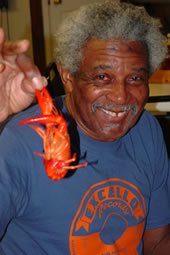 Lazy
Lester Lazy
LesterLeslie Johnson was born June 20, 1933 in the small town of Torras, Louisiana, and was raised mostly in Scotlandville, a suburb of Baton Rouge. As a boy, he worked at a grocery store, where he purchased a harmonica and Little Walter's famous "Juke" record. Lester began to blow harp and later learned to strum his brother's guitar. It was in the mid-1950s that fate turned Lester's way. Lester was living in Rayne, Louisiana, at the time and was on the bus riding home. Lightnin' Slim, who was already an established recording artist, was also on the bus and was headed to Crowley to cut a record at Jay Miller's Studio, where so much of the material for the Nashville-based Excello Records was being recorded. Lester stayed on the bus and accompanied Slim to the studio. When they got there, the scheduled harp player didn't show for the session. Lester told Slim that he thought he could handle the harp parts for the recording. Remarkably, Slim and Miller gave Lester that chance, and he did not disappoint. A classic pairing was born, and Lester became a mainstay on Slim's Excello recordings and his gigs. Miller was impressed by Lester's work, and in 1957 Lester debuted as a lead artist on Excello. Before Lester's debut record release, Miller had decided that "Lazy Lester" had more of a ring to it than "Lester Johnson." Lester's first legitimate hits came in 1958 with the release of "I'm A Lover Not A Fighter" backed with "Sugar Coated Love." Those two songs established Lester as a star. He hit again with the follow-up record, "I Hear You Knockin'"/"Through The Goodness of My Heart." Lester remained a regular Excello artist, making 15 records for the company. In 1975, Lester moved to Pontiac, Michigan. He retired from music until the late '80s when he recorded Lazy Lester Rides Again for the Blue Horizon label, winning a W.C. Handy Award. That led to a deal with Alligator Records. Since, he's recorded twice for Antone's and one direct-to-disc for APO Records, recorded at Blue Heaven Studios. |
| Saturday, October 17th |
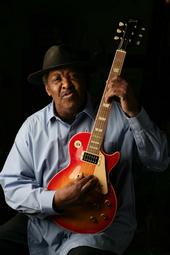 Magic
Slim Magic
Slim Magic Slim was born Morris Holt in Torrence, Mississippi, in 1937. His mother and father were sharecroppers; they lived on a farm where everyone in the family would get up early in the morning to slop the hogs, feed the chickens, catch the mule and go out into the fields. "I still had to go to the field until I got age enough to leave home," Slim says. "I got little jobs around there when I was 13 and that was when I got my hand hurt. I hurt it in a cotton gin. I was at the gin and my hand got caught on a piece of wire going up in there, and I grabbed it and before I could turn it loose, I lost my little pinky finger." Slim showed his musical talents early, singing in church and playing piano. His accident limited his piano abilities, so he picked up the guitar. He made his first guitar out of bailing wire from a broom, which he nailed to a wall. "My Mama whipped me when I tore up her broom," he said, "but she let me keep on using it, and Mama said later that if she had known what I would be into later in life, she would not have given me a whipping." It was in 1955 when Slim made his first trek to Chicago, to play bass for Magic Sam, a friend of his from home. It was Magic Sam who named his new bass player "Magic Slim," because back then Slim was quite lean and tall. Sam also gave Slim invaluable musical advice. "Magic Sam told me, 'do not try to play like him, and do not try to play like no one else; he said, 'get a sound of your own.'" What Slim came up with is a guitar tone that is tough and cutting, united with a vibrato formed by using his fingers against the strings to reproduce the sound of a slide guitar while still being able to bend the notes. "I slide with my finger," Slim says. "I don’t use nothing on my finger. A lot of players try to get a sound like me and can't. I play the same guitar everybody else does." Slim's style is
raw and intense, a real blood-and-guts, down-and-dirty
mix of country roadhouse and urban ghetto. There's
no faking real, and at the end of the day it's real
that wins the crowds, which is why Magic Slim and
the Teardrops enjoy many, many more repeat bookings
than most blues bands on today's circuit. This group
is always working, crisscrossing the country and
hopping planes around the world. Slim adheres to
no set list and claims a song repertoire numbering
in the hundreds. "I see
what kind of crowd it is," he says on deciding where
to take his shows. "I play a few songs and see how
the people react and go from there." |
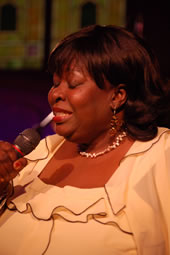 Diunna Greenleaf Diunna GreenleafDiunna Greenleaf, of Houston, Texas, has a background steeped in both blues and gospel. She's been influenced by the likes of Koko Taylor, Aretha Franklin, Rosetta Thorpe, Sam Cooke and Charles Brown, and she includes intricate patches of jazz and soul in her performances. Greenleaf came to the life of professional performing quite late, considering how much talent she had to offer. She worked as a school counselor and occasionally sang rather informally for children's and educational benefits. She and her band played a small show at a hospice in celebration of Houston blues legend Teddy "Cry Cry" Reynolds' birthday. Afterwards, Reynolds told Greenleaf of how he'd known her parents, both gospel musicians, and how she was not only very talented but also had a duty to continue the family legacy of performing. So insistent was Reynolds that he solicited the opinion of his old friend Katie Webster, the Swamp Boogie Queen. Webster confirmed Reynolds' assessment and encouraged Greenleaf to seriously pursue a life in music, even giving her newfound protégé typed rules for forming and leading a band. In 2005, Greenleaf and her band Blue Mercy represented Houston in the International Blues Challenge, an annual contest in Memphis that features the world's best unsigned blues bands. Greenleaf and Blue Mercy finished first out of 84 bands from 32 states and eight countries. What's more, Blue Mercy's guitarist, John Richardson, earned the Albert King Award for Most Promising Guitarist. From there, the gigs came steadily, and the group's been booked solid ever since. Greenleaf also served for three years as president of the Houston Blues Society, becoming the first woman elected to that post. As president, she produced the Willie Mae Thorton Blues Festival, bringing in such talent as Texas Johnny Brown, I.J. Gosey, Koko Taylor, Bernard Allison, Mel Waiters and others. Greenleaf closed the 2006 Blues Masters and absolutely floored the Blue Heaven Studios congregation. So powerful and dynamic and soul-stirring was her and her band's performance that many concert regulars have commented that Greenleaf remains their favorite act through all the years. To say she is back by popular demand is a wild understatement. |
 Honeyboy Edwards
Honeyboy EdwardsThe whole reason the Blues Masters at the Crossroads began in 1998 was to showcase and document artists like Honeyboy Edwards. Now, there are no more artists like Honeyboy Edwards. There were nine headliner performers at the first Blues Masters. Only three of them are still living. Two – Jimmy D. Lane and Eomot RaSun – were the definite Young Turks of Blues Masters one. The other is David "Honeyboy" Edwards, truly the last of a breed. The word "breed" applies because think about this: At 94 years old, Edwards and Blues Masters alum Pinetop Perkins are the very end of the road as it concerns bluesmen with links to the origins of blues recordings. They're among the last with ties to sharecropping, who picked cotton, who hoboed trains – the last to live a life reminiscent of the themes we so strongly associate with classic blues. Edwards was born June 28, 1915 in Shaw, Mississippi. Of his earliest musical inspiration, Edwards says in his autobiography The World Don't Owe Me Nothing, "it was in '29 when Tommy Johnson come down from Crystal Springs, Mississippi. He was just a little guy, tan colored, easy-going; but he drank a whole lot. At nighttime, we'd go there and listen to Tommy Johnson play. Listening to Tommy, that's when I really learned something about how to play guitar." Edwards' life has been intertwined with almost every major blues legend, including Robert Johnson, Charley Patton, Big Joe Williams, Rice "Sonny Boy Williamson" Miller, Howlin' Wolf, Peetie Wheatstraw, Sunnyland Slim, Lightnin' Hopkins, Big Walter, Little Walter, Magic Sam, Muddy Waters and on and on. In 1942, Alan Lomax recorded Edwards in Clarksdale, Mississippi, for the Library of Congress. He recorded 15 sides of Edwards' music. Edwards didn't record again commercially until 1951, when he cut "Who May Your Regular Be" for Arc Records. He also recorded "Build A Cave" as "Mr. Honey" for Artist. Moving to Chicago in the early '50s, Edwards played small clubs and street corners with Floyd Jones, Johnny Temple and Kansas City Red. In '53, he recorded several songs for Chess that remained un-issued until "Drop Down Mama" was included in an anthology release. Edwards began a still-ongoing association with Earwig Records in 1979 when he and his friends Sunnyland Slim, Kansas City Red, Floyd Jones and Big Walter Horton recorded Old Friends for the label. Earwig also released Edwards' Library of Congress performances along with more recent recordings as part of Delta Bluesman in 1992. What a remarkable treat to hear the undisputed elder statesman, the very last link to Robert Johnson, to Charley Patton to Alan Lomax to plantation living. That's living, breathing history sitting up on that stage. And when he's gone, so too is one hell of an important era. |
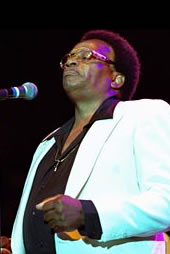 Howard Tate Howard Tate
Singer Howard Tate cracked the R&B Top 20 three times in the late 1960s, left music and endured hardship and anonymity for nearly 30 years and beginning in the early 2000s returned to his rightful place as one of America's most revered soul performers. Tate was born in Macon, Georgia, in 1939 and moved with his family to Philadelphia as a young boy. In his teens, he joined a north Philadelphia gospel group, the Gainors, that also featured to-be star Garnet Mimms. The group recorded in the early 1960s for Mercury Records and Cameo Records before Tate left to become the featured singer of organist Bill Doggett's group. In the mid-'60s, Mimms urged producer Jerry Ragovoy to check out Tate, and from 1966 to 1969 Tate and Ragovoy recorded about 10 singles, the first for the Utopia label, the rest for Verve. "Ain't Nobody Home" (1966), "Look At Granny Run Run" (1966) and "Stop" (1967), all written or co-written by Ragovoy, each charted R&B Top 20. But to rock audiences, Tate was best known as the original performer of "Get It While You Can," which became one of Janis Joplin's signature tunes. Tate's debut album, Get It While You Can, was released in 1966 to tremendous acclaim. Rolling Stone called the album "a spectacular showcase of suave, muscular good-powered singing, heavily influenced by Sam Cooke, with a joyous, shrieking falsetto that became Tate's trademark." Tate recorded a few more singles for Lloyd Price's label, Turntable, before reuniting briefly with Ragovoy for sessions on Atlantic. After one more single on Epic in 1974, Tate all but vanished. Despite his success, he was unhappy with how the music business was treating him, never having seen any royalties. Tate sold securities in the New Jersey and Philadelphia areas into the 1980s before he succumbed to substance abuse and endured a very tumultuous period of homelessness and personal loss. He turned his life around and began work as a minister and counselor in the early 1990s. Then in 2001, a musician Tate had toured with back in the 1960s ran into him in a supermarket and within hours Tate's old producer, Jerry Ragovoy, was calling, resulting in a return to the studio for the Grammy-nominated Rediscovered. He followed up with Howard Tate Live in 2006, A Portrait Of Howard - with guests Lou Reed, Carla Bley and Larry Goldings – in 2007 and Blue Day in 2008. Music luminaries have recognized and celebrated Tate's trademark voice throughout the years, with Elvis Costello calling him "the missing link between Jackie Wilson and Al Green." Among the well-known musicians that have covered songs originally recorded by Tate are Joplin ("Get It While You Can"), Jimi Hendrix ("Stop"), Hugh Masekela ("Stop"), B.B. King ("Ain't Nobody Home"), Ry Cooder ("Look At Granny Run Run") and Grand Funk Railroad ("Look At Granny Run Run"). |
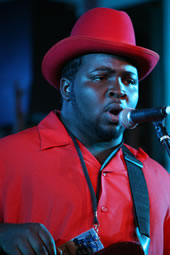 Marquise
Knox Marquise
Knox
Man Child is the title of Marquise Knox's national debut record, and for good reason. Yes, he was just 16 years old for this recording at Blue Heaven Studios and released on APO Records, but no, this is not another one of those guitar-hero, someday-my-vocals-may-mature, I-might-one-day-write-my-own-material records. This kid is flat-out for real! This is a man-sized offering of serious, mature blues. In fact, it's the maturity that provides the shock value here. Sixteen years old?! Listen to that voice and you'll swear he's lying about his age. Guitar licks that are tasty and restrained, none of this hyper-active, self-absorbed speed metal that somehow gets confused with blues. Knox has already won the approval of B.B. King, Henry Townsend, Robert Lockwood Jr., Big George Brock, Bob Margolin, Sam Lay…Read those names again. Do you really think we're talking about a novelty act here? And he's an original. All but one of the tracks on Man Child were penned by Knox, and most of them were written in the studio, on-the-fly, a skill learned at least partially by one of Knox's main heroes, Henry Townsend. Knox has performed at the past two Blues Masters bills. As the youngest performer on bills chock full of legends, he still prevailed as one of each weekend's most obvious crowd favorites. Now 18 years old, this is an inner-city kid who somehow has decided to become a dead-serious bluesman of the old-school variety. That just doesn't happen anymore. Clear the way for the Man Child. Check out his CD Marquise Knox - Man Child. |
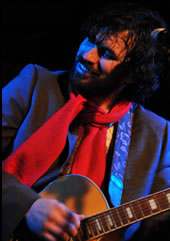 Dan
Dyer Dan
DyerIt may be generalizing. Hopefully it isn't racist. But let's face it: Dan Dyer has one hell of a soulful voice for a white guy. It's a soulful voice for anybody. But for a white guy?! Close your eyes and you're likely to picture something more along the lines of Al Green or Stevie Wonder or Sly Stone than some east Texan around 40 years old. But this is Dan Dyer's gift – a voice oozing soul and deeply introspective, serious songwriting. Dyer was born and raised in the small east Texas town of Tool. He was given a guitar at age 5 but didn't learn to play until he was 18 and had moved to Austin, Texas. It was there that he began to study music seriously, attacking the guitar, and exploring his until-then untapped singing and songwriting powers. While attending Texas State in San Marcos, Texas, Dyer formed a band, Breedlove, with guitarist Tyrone Vaughan (son of Jimmie Vaughan), drummer Jason White, keyboardist Ezra Reynolds and bassist Josh Dawkins. The group developed a dedicated following and released Reach Out in 1996 before disbanding in 1998. From there, Dyer moved to New York City and began writing commercial music jingles, having songs placed in marketing campaigns for Budweiser, Chevrolet, Dr. Pepper and Campbell's Soup. While there, Lenny Kravitz, who had just begun a Warner Bros. imprint called Roxie Records, signed Dyer and produced his What Lies Beneath record in 2004, the first release on the label. Kravitz co-wrote four of the songs with Dyer and also played guitar on the record. After touring for a year behind What Lies Beneath, Dyer moved to St. Louis and started a family. In 2007, he returned to Austin where he'd reunited with friend David Boyle, who recorded and produced Dyer in his converted-church studio for the self-titled Dan Dyer. The record was released in 2008 on Fat Caddy Records. From the chain gang-inspired sound of "Love Chain" to the gospel-tinged "I Walk On Gilded Splinters" and Stewart Copeland-esque syncopations of "Play On Little Children," Dyer and Boyle weave a diverse fabric that extends beyond conventional musical boundaries. |
| Accommodations and Recommended Restaraunts |
